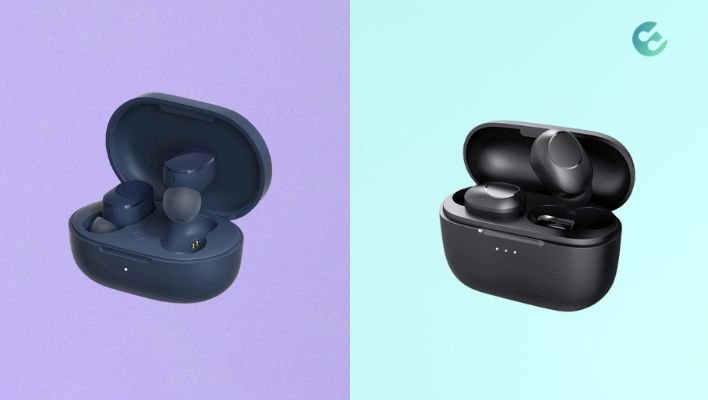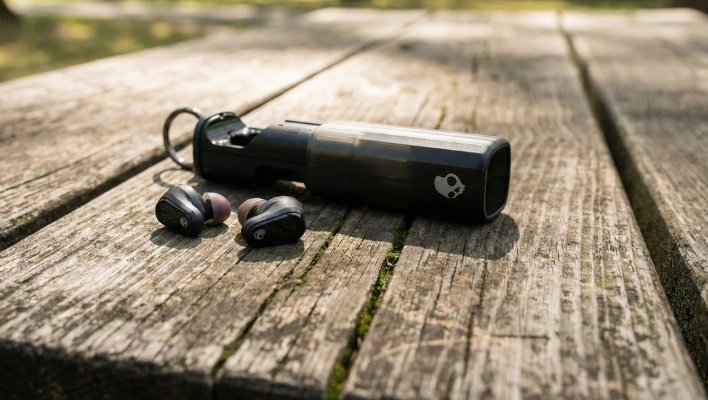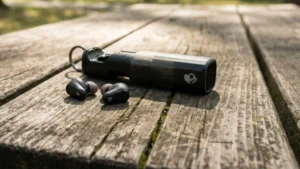The Redmi Airdots 3 and the Haylou GT5 are two popular wireless earbuds that sell like hotcakes. Both offer great value for money, but which one is the better pick?
In this article, I’ll be comparing the two based on design, battery life, sound quality, and other key factors to help you decide which pair suits you best.
Redmi Airdots 3 vs Haylou GT5: Specs Comparison
| Category | Redmi AirDots 3 | Haylou GT5 |
|---|---|---|
| Bluetooth Version | Bluetooth 5.2 | Bluetooth 5.0 |
| Chip | Qualcomm QCC3040 | – |
| Codec Support | aptX (Low Latency) | – |
| Sound Units | Dual for High & Low Frequencies | – |
| Wear Detection | Yes (Auto Play/Pause) | – |
| Earbud weight | 4.6g each | 3.9g |
| Case Dimensions | 65x42x32mm, 51g | – |
| Water Resistance | IPX4 | Yes |
| Earbud Battery | 43mAh (7hr playback) | 40mAh (4hr playback) |
| Case Battery | 600mAh (30hr total) | 580mAh (24hr total) |
| Range | 10m | 10m |
| Supported Protocols | – | HFP/HSP/A2DP/AVRCP |
Redmi Airdots 3 vs Haylou GT5: In-depth Review
Design and Comfort
Let’s start with the design and how comfortably they fit in the ears. The Redmi Airdots 3 and Haylou GT5 have pretty similar stem-shaped designs reminiscent of Apple’s AirPods. However, the Airdots 3 buds themselves are a tad larger than the GT5 buds. Both come with swappable silicone ear tips to help you get a secure, comfortable fit.
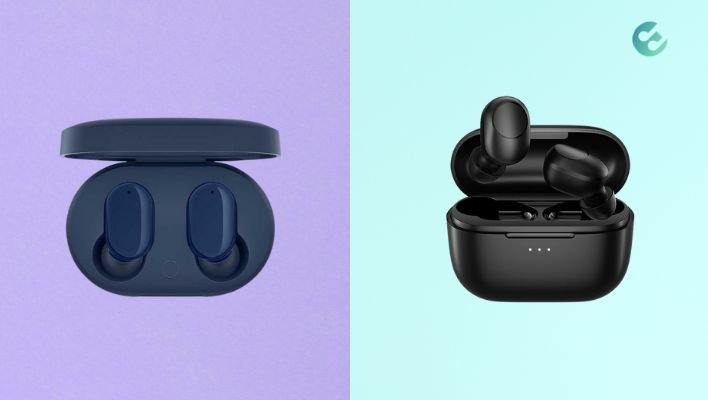
I found both earbuds to be quite comfortable for extended listening sessions. The ear tips create a snug in-ear seal to keep them securely in place even during workouts or runs. I gave them both a good shake test, and neither budged from my ears.
Battery Life
Battery life is crucial for true wireless earbuds, and in this department, the Redmi Airdots 3 has a slight edge. Each Airdots 3 earbud packs a 43mAh battery that provides up to 7 hours of continuous playback on a single charge. The charging case holds an additional 600mAh charge for around 28 hours of total playback.
The Haylou GT5, on the other hand, gets you around 4 hours of listening time per charge from its 40mAh earbud batteries. Its charging case has a 580mAh capacity, providing roughly 24 hours of total battery life when topped up.
So if you need longer battery life between charges, the Airdots 3 is the better choice. But both should get you through a full workday or workout routine on a single charge from their cases.
Sound Quality
When it comes to audio performance, both the Redmi Airdots 3 and Haylou GT5 punch well above their price tags. I was impressed by the overall sound quality, with punchy bass, clear mids, and decent treble detail.
That said, the Haylou GT5 does have a slight edge in maximum volume output. Its drivers can get a tad louder without distorting compared to the Airdots 3. But we’re splitting hairs here – both have perfectly adequate loudness for most situations.
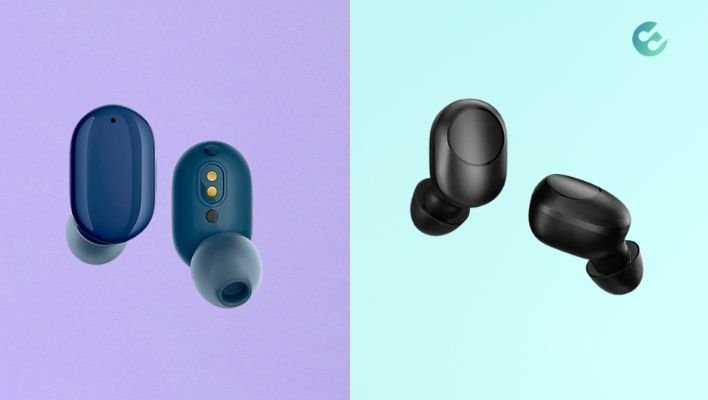
What gives the Airdots 3 an advantage is support for the AAC Bluetooth codec on certain Xiaomi phones. This allows for better sound quality compared to just the SBC codec used by the GT5. The difference isn’t night and day, but audiophiles will appreciate the higher fidelity.
Microphone Quality
For taking calls or voice recordings, I found the microphone quality on both models to be acceptable but not spectacular. The Airdots 3 mic sounded slightly louder and fuller to my ears during testing.
Neither set of earbuds will give you broadcast-quality audio, but they’ll get the job done for casual calls or voice notes. Just don’t expect miracles in noisy environments.
Connection and Latency
Sporting Bluetooth 5.2 and 5.0 respectively, the Redmi Airdots 3 and Haylou GT5 both provide a stable wireless connection with minimal dropouts. I could wander over 30 feet away from my phone before experiencing any hiccups.
Where the Airdots 3 has an edge is its lower latency “gaming mode” for delay-sensitive applications like mobile games or videos. While the GT5’s gaming mode is decent, the Airdots 3 exhibited slightly snappier response times during my testing.
If you’re a mobile gamer, the better latency performance gives Redmi’s buds a slight advantage. But for regular music listening and videos, you likely won’t notice much difference.
Extra Features
Both the Airdots 3 and GT5 have in-ear detection sensors that automatically pause playback when you remove an earbud. Very handy for not missing anything important.
The GT5 additionally supports wireless charging through its case, which is a nice perk the Airdots 3 lacks.
As for companion apps, only the Airdots 3 has one (in Chinese) that lets you customize touch controls and other settings on select Xiaomi phones.
Pricing and Value
At their regular prices, there’s only about a $10-15 difference between the Redmi Airdots 3 and Haylou GT5, with the Airdots being the pricier model.
However, prices can fluctuate based on sales and promotions. At the time of writing the article, the Airdots 3 was around $35 while the GT5 was $22.
Considering the better battery life, lower latency gaming mode, and official AAC codec support, I’d say the Redmi Airdots 3 offers better overall value if you can find it for under $40. But the GT5 is still an incredible value pick under $25.
Where to Buy?
Redmi Airdots 3: View on AliExpress
Haylou GT5: View on AliExpress
Redmi Airdots 3 vs Haylou GT5: Final Verdict
So which affordable true wireless earbuds should you buy – the Redmi Airdots 3 or Haylou GT5? Here’s my recommendation:
Go for the Redmi Airdots 3 if:
- You need all-day battery life from the earbuds + case
- You’re a mobile gamer and need low latency
- You want the option of using AAC codec on Xiaomi phones
- You don’t mind paying a bit extra for those extras
But pick the Haylou GT5 if:
- You’re on a tighter budget
- You just need basic true wireless earbuds for music/calls
- You want wireless charging support
Honestly, you can’t go too wrong with either pick in this budget range. But hopefully, this comparison has given you enough info to choose the right affordable true wireless earbuds for your needs.
Let me know in the comments below which one you ended up going for!
You may also like to see:
Redmi Buds 4 Pro vs Redmi Buds 4 Active
Nick, the Co-founder of Earbuds Arena, is a seasoned freelance tech journalist with over ten years of experience covering wearables, apps, headphones, and gadgets. When he’s not immersed in the tech world, you’ll likely find him unwinding with video games, going for a run, or enjoying a game of soccer on the field.
